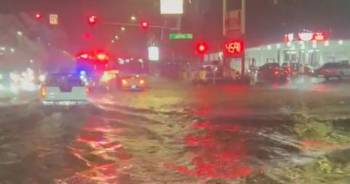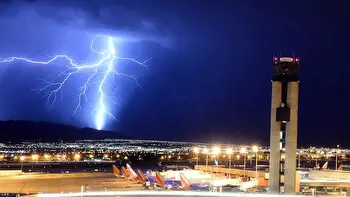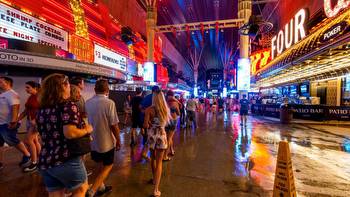Southwest rains flood deserts, cascade into Vegas casinos

LAS VEGAS (AP) — Intense summer thunderstorms that drenched parts of Las Vegas — causing water to cascade from casino ceilings and pool on the carpet of a stadium-sized sports betting area — were part of a broad regional monsoon pattern that may repeat through the weekend, a National Weather Service official said Friday.
“We’re getting right into the heart of the most active part,” said John Adair, a veteran meteorologist at the weather service office near Harry Reid International Airport in Las Vegas. “This is turning out to be a pretty active monsoon season, compared with the last five years or so. There’s plenty of more opportunities for thunderstorms to develop.”
The annual weather pattern has brought a parade of storms across the U.S. Southwest in recent weeks that lead to flooding in normally dry washes, rain measured in inches and rescue operations.
In Arizona, a driver had to be rescued from a vehicle caught in floodwaters in Apache Junction. A youth conservation crew abandoned the red truck they were riding in at Canyon de Chelly National Monument on the Navajo Nation when it got stuck in the mud and water rose around it. Mohave County sheriff’s officials rescued a woman who was clinging to a stop sign earlier this week after her car was swept away.
Parts of the Hualapai Mountains in Mohave County have received up to 6 inches (15.2 centimeters) of rain in recent days, Adair said. The National Weather Service said parts of Arizona can expect 1 (2.5 centimeters) to 2 (5 centimeters) inches of rain per hour before a flood watch expired Saturday morning.
While the rain is welcome in a region gripped by drought, it creates headaches for neighborhoods where wildfires have stripped the land of vegetation, which normally slows and partially absorbs floodwaters.
New Mexico Gov. Michelle Lujan Grisham said Thursday the Federal Emergency Management Agency granted a request to include effects of flooding and mudslides in certain counties hit by massive wildfires this year to the state's disaster declaration.
In northern Arizona, Flagstaff residents have grown accustomed to constant alerts on cell phones and sirens in neighborhoods warning of imminent flooding.
Bret Henneman estimates he has about 3,500 sandbags around his home just north of Flagstaff where two wildfires burned this spring. His wife was babysitting and had the back door open two weeks ago when heavy rain fell and sent a few inches of rain and mud through the home.
With every flood alert, they now cringe.
“We still need the rains and all that and we really need the monsoons around here,” said Henneman, who is staying with family while his house dries out. “It's just that wildfires have changed everything. So, yeah, when it does rain, we're in fear.”
Parts of Arizona, including the towns of Heber, Show Low, Bellemont and Prescott, are near or above 200% of normal rainfall so far during the monsoon, which started June 15 and runs through September. The weather pattern is hit-and-miss, though, meaning some places like Payson are far below normal.
“There's not really a good explanation for why that occurs, but that's part of the nature of storms,” said Valerie Meola, a meteorologist with the weather service in Flagstaff.
Jacquetta Brown was walking on a trail in Canyon de Chelly near Chinle, Arizona, this week when heavy rain swept through and she spotted the red truck partially submerged. The rain is a blessing for crops that families plant in the canyon and livestock, she said, but the monsoon also comes with a downside.
“We have dirt roads here, and when we can't cross the wash, we can't get to work and school,” Brown said.
While only 0.3 inch (0.76 centimeters) of rain was registered at the Las Vegas airport late Thursday, more than 1 inch (2.5 centimeters) fell just 1 mile (1.6 kilometers) away at the University of Nevada, Las Vegas, Adair said.
Nearby wind gusts peaked at 71 mph (114 kph) and toppled trees. Pea-sized hail fell from lightning-streaked skies in suburban Henderson, where almost 1 inch (2.5 centimeters) of rain fell in some areas.
Police, county and city officials and the weather service said no injuries or widespread damage was reported.
Casino patrons posted videos of water pouring from ceilings at Caesars Palace and Planet Hollywood resorts on the Las Vegas Strip and from behind a huge video display at the downtown Circa hotel-casino sports book. One video showed a man continuing to gamble at a casino slot machine while water fell around him.
“A night we’ll never forget,” Circa owner Derek Stevens said in a Twitter post.
“Last night’s weather took Vegas by storm and we were no exception,” Stevens said Friday. “But the show must go on and I’m happy to share that repairs are underway.”
Roped-off sports book seats were expected to reopen during the weekend, he said.
Rapid runoff from sunbaked lots flooded street intersections, prompting vehicles to creep through high water near Las Vegas Boulevard and Main Street. Flood-control channels turned to roiling torrents. Scattered power outages were reported in places including the downtown Fremont Street Experience casino pedestrian mall.
Las Vegas firefighters responded to 330 calls for service and swift-water teams rescued seven people between 9 p.m. and midnight, city spokesman Jace Radke said. Clark County firefighters responded to six water rescue calls, county spokeswoman Stacey Welling said.
Adair said the Las Vegas area usually receives around 4.2 inches (10.7 centimeters) of rain per year, but the official measuring station at the airport has recorded less than 0.7 inch (1.8 centimeters) in 2022.
The surface level at the region’s drought-stricken water supply — the Lake Mead reservoir behind Hoover Dam on the Colorado River — has dropped to less than 30%.
While runoff from storms in the Las Vegas area will reach the lake, monsoon moisture is not likely to affect the ongoing regional drought, Adair said.
“For that, we generally rely on the winter season, where we get multiple Pacific storms coming in and covering a wide area with rain and snow,” the meteorologist said. “That can make a significant impact on drought.”
Fonseca reported from Flagstaff, Arizona.




































